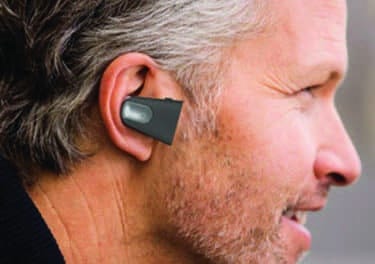Last week, Hearing Review featured the top-25 news stories that helped change the industry in 2016. This week, we feature 10 excellent articles in The Hearing Review during 2016, followed by several other articles and columns you shouldn’t miss (listed in chronological order).
What Is the Most Efficient Reimbursement System in Europe? By Luis Godinho
January 2016 HR. Among the various reimbursement schemes for hearing aids in Europe, is one system more efficient than the others? This study of seven European countries based on data from EuroTrak 2012 and the Market Study of Western Europe 2011 provides a perspective by longtime industry observer and hearing aid specialist Luis Godinho.
A Counterpoint to the PCAST Recommendations, By David J. Smriga, MA
February 2016 HR. David Smriga points out that OTC/DTC hearing aids have their place, but for the majority of adults with mild-to-moderate age-related hearing losses, a guided process including fitting verification and auditory rehabilitation is needed to achieve maximum benefit with amplification. Consumers should be directed toward professional care practices that offer these services, not away from them. Read the point-by-point argument against the PCAST’s recent conclusions.
Multi-channel Compression: Concepts and (Early but Timeless) Results, By Inga Holube, PhD, Volkmar Hamacher, PhD, and Mead C. Killion, PhD
February 2016 HR. The authors look back at a study from 2000 that showed short time constants and a large number of independent compression channels reduced the temporal and spectral contrast of speech when using technology of that period. Additionally, in subjective paired comparisons, long time constants, low compression ratios, and a small number of compression channels were preferred in the investigated technology configuration by normal-hearing and hearing-impaired listeners.
Understanding How RECDs Fit into the “Big Picture” of Hearing Aid Fitting, By Danielle Glista, PhD, Marianne Hawkins, MClSc, Sheila Moodie, PhD, and Susan Scollie, PhD
March HR. Since the introduction of real ear measurement systems, real-ear-to-coupler difference (RECD) measurements have become a clinical reality. Understanding the RECD and how it is used in hearing aid fitting software allows clinicians to better define fitting protocols for individual listeners.
The Surprising Success of Digital Noise Reduction, By Douglas L. Beck, AuD, and Thomas Behrens, MScEE
May 2016 HR. Because the literature shows the benefits of DNR include more rapid word learning rates, less listening effort, better recall of words, improved SNR at the hearing aid output, and more, audiologists Beck and Behrens suggest including activation of the DNR circuit as the “go-to” setting for adults and children.
Hearing Aids Improve Hearing–and A LOT More, By Søren Hougaard, MA; Stefan Ruf, MA; Christian Egger, MA, and Harvey Abrams, PhD
June 2016 HR. The authors describe the methodology associated with the world’s largest consumer market surveys on hearing aids and hearing loss, and report their findings with a focus on the “non-auditory benefits” of hearing aids, including quality of life, relationships at home and work, independence, and mental health.
PSAPs vs Hearing Aids: An Electroacoustic Analysis of Performance and Fitting Capabilities, By Chase Smith, Laura Ann Wilber, PhD, and Kim Cavitt, AuD
July 2016 HR. This study evaluates 11 low-end and high-end hearing aids and PSAPs, and shows that all high-end hearing aids were able to fit most audiometric configurations, and 2 high-end PSAPs and 1 app were able to fit up to a moderate loss configuration.
What Hearing Care Professionals Need to Know About Today’s Healthcare Economics, By John Bakke, MD, MBA
October 2016 HR. Hearing care professionals will be increasingly involved in general healthcare and working more closely with doctors as healthcare economics change how primary care physicians are compensated by insurers.
Patient Complexity and Professional Time: Improving Efficiencies in the Service Model, By Dan Quall, MS, and Brian Taylor, AuD
October 2016 HR. The traditional model for serving patients allows for little differentiation for factors such as severe hearing loss, cognitive decline, physical limitations, and dexterity problems, which may end up being unfair to both the consumer and the clinician.
Family-centered Audiology Care: Making Decisions and Setting Goals Together, By Louise Hickson, PhD; Christopher Lind, PhD; Jill Preminger, PhD; Brittany Brose, AuD; Rebecca Hauff, and Joseph Montano, PhD
November 2016 HR. Family-centered Care (FCC) accepts that both the person with hearing loss and those around them should be the focus of audiologic rehabilitation. Strategies revolve around including family in discussions about resolving hearing difficulties and setting goals.
More Must-Reads & Must-See Webinars
And here are a dozen-or-so more excellent articles and great columns that you shouldn’t have missed (also listed chronologically):
Annual Audiological Evaluations Should Be Mandatory for Patients with Diabetes, By Himanshu Kumar Sanju and Prawin Kumar, PhD
January 2016 HR. Early diagnosis and intervention of hearing loss or listening related problems could help in providing better quality of life for individuals with diabetes mellitus. Annual audiological evaluations—which include testing of the peripheral as well as central auditory system—should be added to the list of routine or “standard of care” medical exams.
Steering Into the Winds of Change, Part 2: Three Ways to Attract and Retain More Clients, By Steve Eagon, MA
February 2016 HR. It is not easy to bring patients into the clinic these days. So when a patient does walk through the door of your office, you want to give them an exceptional customer experience. Establishing trust, making the necessary tweaks to achieve a high level of customer satisfaction (delight) at every step, and laying the groundwork for future patient advocacy creates long-term value with your patient, and long-term dividends for your business.
Webinar: Battling Big Box Retailers, By Tina Soika, MS
HR Online. Tina Soika offers a game-plan for competing with Big Box retailers and winning. Soika addresses the power of your unique value proposition and how to develop it; the 6 most successful strategies private practices can utilize to compete against Big Box stores, and how to engage your team in your competitive efforts.
Webinar: How Low Can You Go? Practical Considerations When Offering a Low-priced Hearing Aid, By Dan Quall, MS
HR Online. Dan Quall takes you through the basic steps of establishing a “cost-plus” model for the pricing of lower-cost products and services. With “affordability and accessibility” being the new buzzwords of the hearing industry, this is a “must-see” webinar that provides great practical advice about offering low-cost hearing care options—without threatening the solvency of your business or giving away your valuable services.
Using the Personal Assessment of Communication Abilities (PACA) Tool, By Brian Taylor, AuD, Vinaya Manchaiah, AuD, and Susan Clutterbuck, BSc (Hon)
March HR. Results from this study suggest that younger working adults (under age 60) with normal audiograms may have more self-reported difficulty with communication in common listening situations than most clinicians would expect. Many of the individuals reporting problems in specific listening situations may benefit from situational remediation.
The Final Word: Where Do You Refer a Disgruntled Patient, and How Do You Do It?, By Dennis Van Vliet, AuD
April HR. Dr Van Vliet considers how to refer a patient to a new provider without disrupting continuity of care or the bundled fee service model. What do you do for patients who need full service care, have purchased hearing aids under the model, but have relocated, or do not want to return to the original provider?
Back to Basics: Frequency Compression Is for Speech, Not Music, By Marshall Chasin, AuD
June 2016 HR. Frequency compression can be useful to avoid dead regions in the cochlea for speech, but this does not follow for music. The difference is that in damaged regions—typically in the higher frequencies—speech has a “continuous” spectrum, whereas music is always a “discrete” or “line” spectrum regardless of frequency.
Family-Centered Adult Audiologic Care: A Phonak Position Statement, By Gurjit Singh, PhD; Louise Hickson, PhD; Kris English, PhD; Sigrid Scherpiet, PhD; Ulrike Lemke, PhD; Barbra Timmer, MACAuD; Ora Buerkli-Halevi, MS; Joseph Montano, EdD; Jill Preminger, PhD; Nerina Scarinci, PhD; Gabrielle H. Saunders, PhD; Mary Beth Jennings, PhD, and Stefan Launer, PhD
July 2016 HR. The authors propose an audiologic treatment shift from a site-of-lesion focus to a family-centered care perspective as a means of increasing the value of our services and the uptake of hearing devices.
Sound Quality in Hearing Aid Wireless Streaming Technologies, By Jesper Ramsgaard
August 2016 HR. Hearing aid users will encounter more streamed sounds as the technology spreads, and streaming technologies will potentially reduce the sound quality experience, but there are solutions available for the hearing industry.
Blog Page: Vestibular Fraud and Its Consequences, By Alan Desmond, AuD
August 2016 HR. Dr Desmond says fraudulent use of the billing code for rotational chair testing among providers who are not vestibular specialists led to Medicare making a coding change that reduced reimbursements to legitimate practitioners.
Webinar: Six Simple Ways to Create the Practice of Your Dreams, By Gyl Kasewurm
HR online. Gyl Kasewurm provides “the long view” for how to build the practice of your dreams. In this 17-minute webinar, Dr Kasewurm provides her inside tips for setting and attaining goals, keeping track of the key performance indicators of the practice, concentrating on revenue generation and learning how to delegate, building a strong and loyal patient base, and more.
Unraveling the Mysteries of Wireless Connectivity in Hearing Aids, By Ron J. Leavitt, AuD; Carol Flexer, PhD; Nikki Clark, and Carolyn Rector
September 2016 HR. Wireless connectivity in hearing aids offers potential communication improvement for hearing aid users, but improvement can only be achieved when the end user is skilled in wireless technology, and the hearing care professional has opened the doorway to the brain to the greatest extent possible.
Inside the Research: Musicians, Hearing Preservation, In-ear Monitors, and More: An Interview with Michael Santucci, AuD, By Douglas Beck, AuD
September 2016 HR. Michael Santucci owns Sensaphonics, the only custom-only earphone manufacturer founded and operated by an audiologist. He has provided in-ear monitors (IEMs) to a diverse group of superstars and others with unique hearing monitoring needs.
Speech Intelligibility Benefits of FaceTime: Advantages for Everybody, By Charlotte T. Jespersen, MA, and Brent Kirkwood, PhD
There are benefits to audio streamed bilaterally via MFi to both hearing aids, visual cues through FaceTime, and extended bandwidth. This method delivers 77% in speech understanding on the phone for normal-hearing and mild-to-moderately hearing-impaired individuals, and 72% for severe-to-profound hearing loss.
Blog Page: How Do We Increase Hearing Aid Adoption Rates? By Amyn M. Amlani, PhD, and Holly Hosford-Dunn, PhD
October 2016 HR. In this blog post, Drs Holly Hosford-Dunn and Amyn Amlani analyze the influence of price on the hearing aid market–specifically, the connection between price and hearing aid adoption rates.
Are Hearing Aids the Better Rehabilitative Choice When Compared to PSAPs? By Filip M. Rønne, MScEE, PhD, and Rikke Rossing, MA
November 2016 HR. Two PSAPs are evaluated vs. a hearing aid for listeners with mild-to-moderate hearing loss. For speech intelligibility, the hearing aid performed significantly better than both PSAPs, and was preferred for sound quality.
The Final Word: Van Vliet’s 5-year Predictions for Hearing Healthcare, By Dennis Van Vliet, AuD
November 2016 HR. In his November 2016 column, Dr Van Vliet makes predictions about the directions hearing care may take over the next 5 years in regard to disruptive technology, practice models, ear impressions, hearing aid batteries, and more.
Back to Basics: Electronic Hearing Protection: Does It Work? Marshall Chasin, AuD
December 2016 HR. Electronic hearing protection is useful for hunters, military personnel, and musicians, says Marshall Chasin, AuD. They look and act like hearing aids, and technically (though not in some jurisdictions), they are hearing aids.
Image credits: Dreamstime





